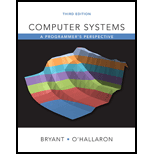
Given Information:
Three different functions are given:
Function-1:
/*clear1 function with a pointer variable and integer as arguments */
void clear1 ( point *p, int n)
{
//variable declaration
int i,j;
//traverse throughout the structure
for(i=0;i<n;i++)
for(j=0;j<3;j++)
//multiply the point with velocity
p[i].vel[j]=0;
for(j=0;j<3;j++)
//multiply the point with acceleration
p[i].acc[j]=0;
}
}
Function-2:
/*clear2 function with a pointer variable and integer as arguments */
void clear2 ( point *p, int n)
{
//variable declaration
int i,j;
//traverse throughout the structure
for(i=0;i<n;i++)
for(j=0;j<3;j++)
//multiply the point with velocity
p[i].vel[j]=0;
//multiply the point with acceleration
p[i].acc[j]=0;
}
Function-3:
/*clear3 function with a pointer variable and integer as arguments */
void clear3 ( point *p, int n)
{
//variable declaration
int i,j;
//traverse throughout the structure
for(j=0;j<3;i++)
for(i=0;i<n;j++)
//multiply the point with velocity
p[i].vel[j]=0;
for(i=0;i<n;j++)
//multiply the point with acceleration
p[i].acc[j]=0;
}
}
Want to see the full answer?
Check out a sample textbook solution
Chapter 6 Solutions
Computer Systems: A Programmer's Perspective Plus Mastering Engineering With Pearson Etext -- Access Card Package (3rd Edition)
- Briefly describe the issues involved in using ATM technology in Local Area Networksarrow_forwardFor this question you will perform two levels of quicksort on an array containing these numbers: 59 41 61 73 43 57 50 13 96 88 42 77 27 95 32 89 In the first blank, enter the array contents after the top level partition. In the second blank, enter the array contents after one more partition of the left-hand subarray resulting from the first partition. In the third blank, enter the array contents after one more partition of the right-hand subarray resulting from the first partition. Print the numbers with a single space between them. Use the algorithm we covered in class, in which the first element of the subarray is the partition value. Question 1 options: Blank # 1 Blank # 2 Blank # 3arrow_forward1. Transform the E-R diagram into a set of relations. Country_of Agent ID Agent H Holds Is_Reponsible_for Consignment Number $ Value May Contain Consignment Transports Container Destination Ф R Goes Off Container Number Size Vessel Voyage Registry Vessel ID Voyage_ID Tonnagearrow_forward
- I want to solve 13.2 using matlab please helparrow_forwarda) Show a possible trace of the OSPF algorithm for computing the routing table in Router 2 forthis network.b) Show the messages used by RIP to compute routing tables.arrow_forwardusing r language to answer question 4 Question 4: Obtain a 95% standard normal bootstrap confidence interval, a 95% basic bootstrap confidence interval, and a percentile confidence interval for the ρb12 in Question 3.arrow_forward
 Operations Research : Applications and AlgorithmsComputer ScienceISBN:9780534380588Author:Wayne L. WinstonPublisher:Brooks Cole
Operations Research : Applications and AlgorithmsComputer ScienceISBN:9780534380588Author:Wayne L. WinstonPublisher:Brooks Cole C++ for Engineers and ScientistsComputer ScienceISBN:9781133187844Author:Bronson, Gary J.Publisher:Course Technology Ptr
C++ for Engineers and ScientistsComputer ScienceISBN:9781133187844Author:Bronson, Gary J.Publisher:Course Technology Ptr C++ Programming: From Problem Analysis to Program...Computer ScienceISBN:9781337102087Author:D. S. MalikPublisher:Cengage Learning
C++ Programming: From Problem Analysis to Program...Computer ScienceISBN:9781337102087Author:D. S. MalikPublisher:Cengage Learning


